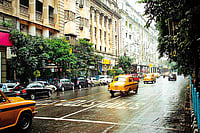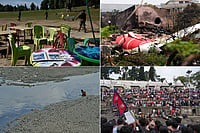A new book of Partition memoirs is not a fait accompli. There could always be some scepticism about what more there could be to Partition than what is known already. After all, it happened seven-and-a-half-decades ago, and hardly any aspect of Partition has remained outside the purview of having become a ‘narrative’.
On the other hand, there would be rejoicing about a new set of additions to Partition testimonials, considering the historical heft of the ‘event’. These reactions could also depend on the geography of readership, for a book about Partition would have far more currency in India’s east and north-west, than in the west and the south. All histories have claimants and dissidents. Partition is no different.
What is evident is that after so many years since the event and numerous testimonials to that effect, one can never seem to come to terms with the enormity and the absurdity of Partition. To be ripped from one’s home and hearth, to be so unkindly banished from one’s own surroundings, to be thrown, lock, stock and barrel into the cauldron of a mass exodus is to have one’s memory scarred forever.
Just a quick recall of Ritwik Ghatak’s Partition Trilogy (1960, 1961, 1962) might help galvanise some of the standard imagery that Partition has provoked artistically. Except Nemai Ghosh’s Chinnamul (The Uprooted, 1950), Ghatak, as editor Angshuman Kar points out, has been that rare artist to have encountered Partition in cinema unencumbered, at least till Garam Hawa (1974). In fact, he invested the act of Partition with the moral and social irretrievability of an apocalypse. There were others too, less direct perhaps. Kar also argues, and rightly so, that the cohort of Partition memoirs have had a disproportionate concentration of those from Punjab, while Bengal’s traumatic years have found themselves less thickly revisited.
Moreover, the understanding of Partition was for long left to statist histories. They do not necessarily capture the haptic disquiet and the lived-in dimensions of a personal tragedy, or the shock and awe of an irreversible convulsion. To that end, it was often said that Partition was everywhere but not anywhere in Bengal, at least in terms of bringing it into the folds of a language of representation. Bengali literature, however, has been much more attentive to Partition than other cultural forms have been, and it is in that legacy that the present collection should be primarily seen.

Hence, for the reader of Divided, the experience can be both moving and unsettling. As one passes from one testimonial to the next, even the most distanced reader would not be able to shake off the acute consciousness of how orality and memory are intertwined with Partition, as it has been for several events that have caused epic ruptures in historical time. Academic Nandini Bhattacharya sets the tone of the book in her foreword, asking questions which are not new but are a necessary roadmap for those unfamiliar with the terrain. She asks, “What were the effects of Partition trauma, how were such hurts remembered, forgotten or recast to cope with psychological disruptions of not just a few individuals but of generations to come? How are such ‘rememorations’ (as Divided is) meaningful for future generations?”
And it is not just one Partition, for even within the fifteen separate memoirs in Divided, ‘Partition’ is a moveable, mutating signifier—a state of being across borders of various kinds, as well as signifying the historical shifts that, in Bengal, came in successive waves from 1947 to 1971.
Kar’s longish introduction is rather helpful, for it not only gives a brief understanding of what constitutes ‘Partition literature’ and what kind of academic work exists in the domain, but also how we might understand the ‘phenomenon’ of Partition, and negotiate it as part of both lived memory and textbook history. To do so, Kar introduces the idea of ‘buoyant memory’. Drawing from Hannah Arendt and Cathy Caruth, he claims that not all memory gets dissolved in the ‘sea of the past’, but rather “floats on the surface and haunts the victims in a repetitive manner”. In other words, he points out the need, rightfully so, of not only bringing to a larger readership a selection of telling memoirs but also to situate them within the field of ‘trauma’ rather than just a historical ‘tragedy’, which was what Partition literature has so far been mostly confined to. I think this is where the book finds its real purpose.
One of the strengths of the collection is its willingness to go beyond what has usually been the preserve of the ‘bhadrolok’ (Bengal’s ‘gentlefolk’). From the middle class, liberal, upper-caste professor to a cow smuggler, the collection opens itself up to the full theatre of humanity affected by borders and partitions. One cannot but be delighted that the fifteen memoirs in the book span gender, class, religiosity and most importantly, caste—the last usually and notoriously invisibilised in the framework of Bengal’s Partition. So, if we have a Tarun Sanyal, we also have a Jharna Basu, a Kapil Krishna Sarkar, a Sita Sarkar, Nishath Jahan Rana, and a Hasan Azizul Hoq.
Interestingly, if read attentively, the memoirs are not just about a single migration or an event that sequestered, in one blunt blow, the past from the present. Rather, what we have is a lambent exploration of power mechanics too, of social hierarchies, of gendered biases, of religious partisanism. These fractures often find release in social violence during times of historical turmoil. At the same time, there are also those who subvert the smallness of men, the felony of politics and the crimes of a time to embrace a fundamental tenet of humanity—empathy.
What is certain is that as a collection of previously untranslated memoirs, Divided is a substantive addition to the literature on Partition and to Partition Studies, and by extension, to Border Studies and Memory Studies, both of which, at least in India, have large areas of concentration on Partition on either side. Moreover, having been born out of a translation workshop, this collection also raises critical questions about the ‘act’ of translation, and also ‘orality’, both key concentrations of historiography in the present. However, this has meant that the translations are ‘uneven’ insofar as they are done by different translators. Also, even if the original Bengali collection as a whole has been rightfully mentioned by Kar, for those unfamiliar with the context, a few more details of the authors and the source-work would have been rather helpful.
The book design is rather pedestrian, given it is aimed at an audience used to much better production. These are not major complaints because they don’t hurt the nature of the collection. In fact, ‘A People’s History of Partition’ is yet to be written. When that happens, this important collection shall stand alongside a handful of those which took the onus of initiating a discussion in that direction.
Sayandeb Chowdhury is assistant professor at the school of letters, Ambedkar University Delhi

























